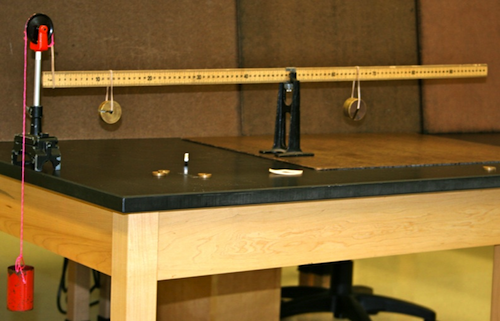

(Be sure to include the correct sign based on the convention for torque.) QUESTION 4: Write down an equation (no numbers, just symbols from Question 3) for each of the torques associated with the forces in your diagram. Label them with appropriate symbols (for example, e.g. Also show the pivot point, and each of the lever arms. QUESTION 3: Draw a sketch of the meter stick and indicate the three forces acting on it. QUESTION 2: How do you know the meter stick is in static equilibrium? Make sure that the force probe and string are vertical. Part IV: Investigation of the Angled Meter Stick Considering equilibrium conditions on a meter stick that is at some angle to the horizontal. If the weight is not close to 1.962 N, recalibrate! You are ready to collect data… Check your calibration: press Collect with 200 g on the probe.

Remove the mass and click the Zero button near the Collect button. Hang the 200 g mass and enter its weight (in newtons) in the Value box, then click Keep. With nothing hanging on the force probe, enter 0 in the Value box, then click Keep. QUESTION 1: What is the weight in newtons of the 200 g mass? ClickĬlick Calibrate Now. A 200 g mass is to be used for calibration. The force probe needs to be calibrated before you can use it for measurements.
#BALANCED TORQUES AND CENTER OF GRAVITY LAB REPORT PRO#
The Logger Pro window should contain a graph of Force vs Time. Launch Logger Pro by clicking on the icon below. Plug the Force Probe into CH 1 on the LabPro. Mount the force probe onto the short rod as shown and tighten the thumbscrew.The hook should be pointing straight down.Įnsure the force probe is set to 5 N or 10 N and not to 50 N. Part III: Calibrating the Force Probe The force probe will not display the correct force in newtons unless we calibrate it by applying two forces of known values.Ĭlamp the short aluminum rod to the long rod screwed into the bench. Record this value and its uncertainty in Table 1.Ĭalculate the weight of the meter stick along with its experimental uncertainty. Measure the mass of the meter stick, with clamps still attached, on a triple beam balance. Record the position of the center of gravity and its uncertainty in Table 1. Do not move either clamp for the rest of the lab.ĭo not move either clamp for the remainder of the lab. Take the meter stick off the stand and measure the position of the pivot clamp on the meter stick. If the stick oscillates slowly and by equal amounts on each side of the pivot then it is balanced. Adjust the position of the pivot clamp that is near the middle of the meter stick until the meter stick is balanced and level. To find the CG of the meter stick, place the meter stick on the pivot using the pivot clamp located near the center. First attach two metal clamps to the meter stick one at the 10 cm mark and the other near the middle. The weight of a rigid body is a downward force acting at the center of gravity (CG) of the body. Part II: Finding the Center of Gravity of the Meter Stick The center of gravity is the single point through which all the weight of the rigid body appears to act.

You will investigate a level meter stick.Īpparatus You should have this apparatus at your station. You will investigate the equilibrium conditions for a case where some of the forces may be at an angle to the rigid body. become familiar with the two conditions for static equilibrium You will also determine the weight and center of gravity of a meter stick. become familiar with the concept of lever arms and torque 2. Introduction In this laboratory you will investigate the concepts of torque and equilibrium. The pivot point may be taken to be any point on the rigid body. Τ = Fl Torques that act to rotate the body in the counter-clockwise direction are positive and those that rotate the body clockwise are negative. the vector sum of torques on the body must be zero.įor a simpler linear body fixed at some pivot, torque depends on two things the force vector F and lever arm l. the vector sum of forces on the body must be zero and 2. The two conditions for the equilibrium of a rigid body (such as a meter stick) are 1. Introduction Static equilibrium is defined as a state where an object is not accelerating in any way. Part I: Introduction Learning about equilibrium Laboratory #6 Equilibrium of a Rigid Bodyįinding the center of gravity of the meter stick


 0 kommentar(er)
0 kommentar(er)
